 |
       |
 |
       |
Kani Kathamani- the fable of the kuravanji presented by Jain University's students - Sumangala Varun e-mail: sumangalavarun@gmail.com December 2, 2019 Bengaluru rasikas were treated to a unique Bharatanatyam production on the folk fortune teller kuravanjis on October 31, 2019. The third semester Master of Performing Arts students of Jain University presented Kani Kathamani, a group presentation on the kuravanjis of Karnataka. The production was a part fulfilment of their course. All aspects were handled entirely by the students. This was the first time that a production on the kuravanji was presented in a group format. The script was composed by the students based on Dr.Manorama B.N's research and the music was composed by D.S. Srivatsa. The jathis were by D.V. Prasanna Kumar. The music ensemble for the evening was headed by Srivatsa on the vocals, Prasanna Kumar on the rhythm pads and special effects, Lingaraju on the mridangam and Gopal at the veena. 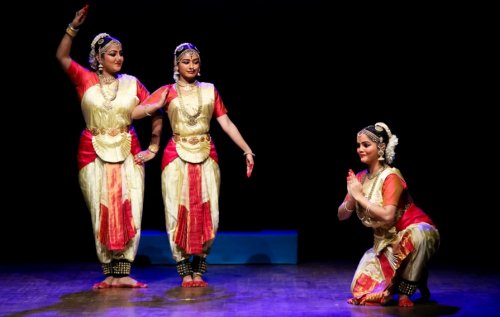 Sutradhar dancers The event began with a brief introduction to the origin of the kuravanji. According to Dr. Manorama's research, it is Lord Shiva and Devi Parvathi who take the form of local soothsayers (kuravan and kurathi) to console a childless Dasaratha. After giving the king a vision of his four sons and their feats, Shiva and Parvathi return to Kailas and leave the kurava and kurathi roopa behind on earth. The students used folk elements in the dance and costumes, replete with shell necklaces, beads and feathers. They also used props effectively across all segments. The students opted to present three stories with the kuravanji as the central character. Three dancers played the role of sutradhars, performing the jathis before each story, and a brief narrative of the story that followed. Their costumes were simple off white and ornaments closely coordinated. Hanumantha kuravanji 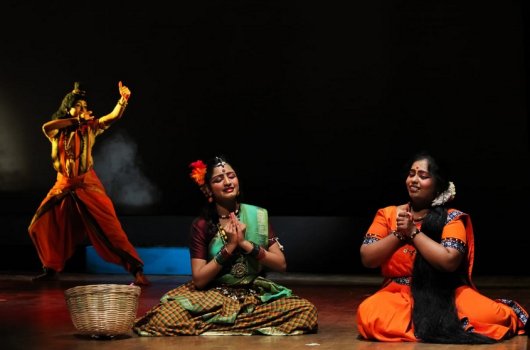 Hanuman kuravanji 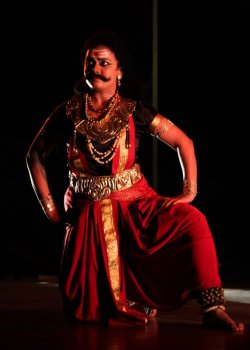 Ravana The first story was about how Lord Hanuman visits Sita Devi when Ravana is holding her captive in Ashoka vana. The piece began with a vigorous jathi. Then followed a brief interaction between Hanuman and two vanaras as he changes his appearance into that of a woman, replete with folk attire and ornaments. Hanuman's interaction with the monkeys was fun, with him teasing the monkeys as they observed his ornaments and watched him transform into the kuravanji. The kuravanji then approaches a forlorn Sita and gives her a glimpse of the future where Lord Rama defeats and kills Ravana in battle. The scene was depicted by dancers in the background with fluid movements. Brahma kuravanji 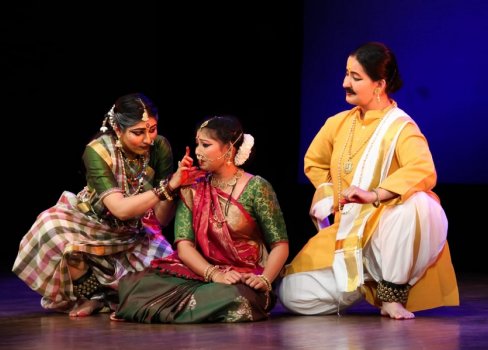 Brahma kuravanji 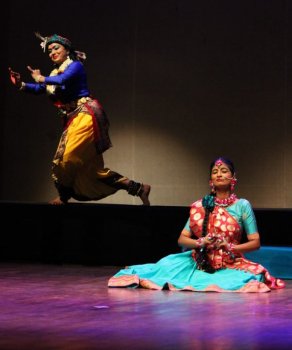 Krishna-Radha The second story was how Lord Brahma takes the form of a kurathi and visits Vasudeva and Devaki, who are expecting their eighth child and are still mourning the deaths of their seven children. The couple is filled with dread at the impending fate of the eighth child at cruel Kamsa's hands. The kurathi shows them how the child will survive Kamsa's hands, will live a happy childhood in Gokula and when the time comes, will kill Kamsa and rid the earth of his atrocities. This segment provided the maximum scope to the dancers for elaboration. The depiction of the Yamuna in spate and the river parting for Vasudeva to cross was impressive with apt use of karanas. The kurathi shows the various feats of Krishna, including Kalinga narthana, lifting the Govardhana during the rains and dancing the rasaleela with the gopis. Srinivasa kuravanji 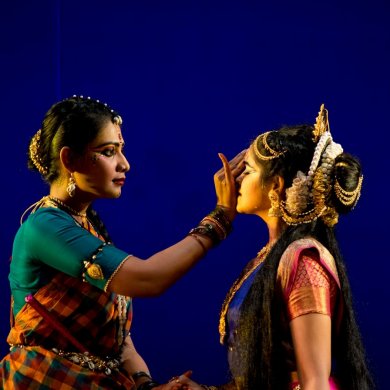 Srinivasa kuravanji 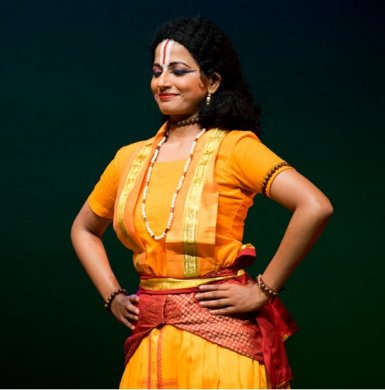 Srinivasa The final piece for the evening was on the story of Srinivasa and Princess Padmavathi. When Srinivasa (an avatara of Lord Vishnu on earth) saves Padmavathi from a wild elephant in the forest, it is love at first sight for the pair. A smitten Srinivasa wants to send a proposal to King Akasaraja and Queen Dharani Devi, the princess's parents but is hesitant to do so as he is a common man and she is a princess. He decides to take the form of a kuravanji and meets the Queen and speaks about Srinivasa. He tells her that Padmavathi is destined to marry Srinivasa and urges her to bless the union. Padmavathi playing with her friends and her meeting Srinivasa were neatly executed. Conclusion A thillana in Valachi provided a fitting finale to the evening. The presentation concluded with a Mangalam of all three deities by offering them arathi and a uyyale seva. The impact could have been deeper if the performers had chosen to wave the arathi with turmeric water and lit camphor with the deities offering dakshina, instead of the empty plate that was used. All three dancers who played the kuravanjis were apt for the role of the fun loving and bubbly kurathi. They had the presence of mind to cover small hurdles and improvise when needed. The students had hand-made a lot of the aharya. The costumes and makeup for characters appeared to be well thought through. The event was presided over by Prof. Vijaya Marthanda, who was the external examiner, Dr. Manorama B.N., and senior gurus including Sathyanarayana Raju, Jyothi Pattabhiram, Kiran Subramanyam, Rekha Dineshkumar and Roopashree Madhusudhan among others, some of whose students were part of the production. The faculty comprising of acharyas Shobha Sasikumar, Dr. Soundarya Srivatsa, Sheela Chandrashekhar, Madhulika Srivatsa, and Arun Sreenivasan were also present. Shobha Sasikumar explained the process of how the students prepared the production. She noted that the students had taken every aspect very seriously. Acknowledging Dr. Manorama's work on the kuravanji, Sasikumar said, "We are grateful to committed and generous researchers who take up such topics and share it with us." She also thanked the students' gurus who send them to enrol in the course with trust in the university and faculty. Vijaya Marthanda noted, "The full hall and applause suggest the quality of the program." She also said that the graph of the choreography's quality keeps going up each year. Dr. Manorama said, "We eagerly await Jain productions each year." She expressed how gratifying it is to a researcher when the research is used. "I am lucky to witness my research come to life through this presentation." She commended the students' talents and efforts, and their successful attempt at taking a folk concept and adapting it to a classical dance form. The evening concluded with the felicitation of gurus and the guests. Sumangala V Varun is a dancer and a freelance writer from Bangalore. |